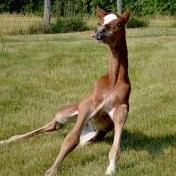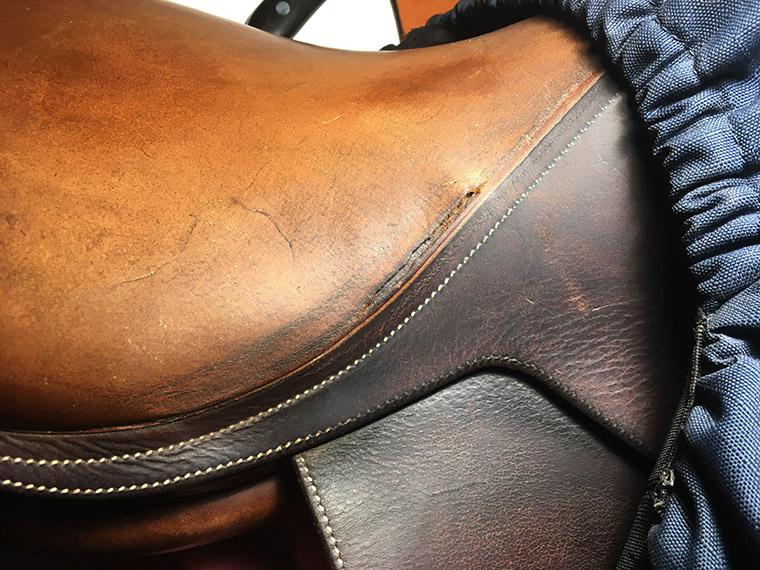-
Posts
1,288 -
Joined
-
Last visited
Content Type
Profiles
Forums
Events
Blogs
Gallery
Everything posted by TomE
-

Saddlery Workshop - Kings Troop, Royal Horse Artillery
TomE replied to StuH's topic in Sewing Leather
I really enjoyed this. Thanks for sharing. Great to see them carrying on the tradition. -

Stretching leather for a set of sliding reins
TomE replied to Mulesaw's topic in Saddle and Tack Accessory Items
Thanks, Jonas. I would welcome a tutorial. I am still learning to use a patcher. Its walking foot is more prone to slip than the compound walking foot machines I am used to. I did smooth and polish the foot to decrease marks on the leather but it still has a fairly positive transport action. Trying to power through the learning curve on boot zippers and I’d welcome any advice. -

Stretching leather for a set of sliding reins
TomE replied to Mulesaw's topic in Saddle and Tack Accessory Items
Neat solution! Would require a big cow for 8+ ft reins. Now I'm thinking that I need to make a pair. p.s. Just finished replacing zippers on the boots-from-hell. Tonics tall boots with a curved zipper on the outside of the leg. They were so heavily oiled that barge cement and/or sticky basting tape wouldn't hold the layers together for sewing. Had to manhandle them and broke a couple of needles, but all's well that ends well. -
Those are good looking sheaths! I like the straps and multiple points for attaching to a person, saddle, etc.
-
Thanks, Jonas. I will check out the logistics. Our President has made it more expensive to order from Europe. The diecast hardware isn't as strong as stainless, and the plating can chip off. Nickel bronze hardware is good quality but less readily available in my experience. Thank you for the tip.
-
Thanks for your reply. They don't have the stainess snaps. Client decided on the nickel plated diecast spring snaps.
-
As the title says, I am looking for a stainless snap hook for a 1/2" strap. The picture shows the broken snap hook and a 1" snap of the type I am searching for. I have only found zinc diecast 1/2" snap hooks with the spring metal clip - these are poor quality and break easily. Beiler's has a 5/8" stainless snap hook that might do if the client approves. I have already checked Beiler's Manufacturing, Weaver Leather Supply, Zack White Leather, Pan Handle Leather, Wyoming Leather, Rocky Mountain Leather, Buckle Guy, Abbey England, and Batz Corp. Thanks for any help you can provide.
-
That's quite a project. Well done! Did you adjust the bobbin case spring tension to cover all those thread sizes? I haven't tried #207 thread in my Cobra Class 29 patcher.
-
I make halters to measure, but if you can get your hands on a halter that fits then you can adjust your pattern. There's not universal agreement on horse sizes - cob, horse, warmblood, draft etc. I include some measurements that I use in this thread.
-
Beautiful craftsmanship. I can’t imagine how long it takes to make these reins. Thanks for sharing.
-

Belt cutting machines always slightly narrower than "belt width"?
TomE replied to nstarleather's topic in How Do I Do That?
I see the discrepancies when repairing tack made in Asia, which is the majority of manufactured tack. The hardware matches inches but the straps are narrower making them loose on the hardware and promoting wear. For economical repairs (matching the client's expectations for inexpensive tack) I have to fudge the width when splicing a new end on a strap. I always check the setting on my plough gauge with a scrap of leather to ensure I'm getting accurate widths. I realize this is a bit off topic. -
Looks very professional to me. Lots better than my baseball stitching. Do you use one needle or two? Are you prepunching holes or using a sharp/glovers needle? I'm trying to get the hang of baseball stitching to secure thin patches as an inexpensive leather repair. Would welcome any tips.
-
Or use a sewing awl instead of pre-punching holes that take up excess dye.
-
That's a neat looking repair, Jonas. Better than new. The trend towards using soft leather for dressage saddles should be a boost to the repair business. I've been asked about a similar repair but the saddle hasn't arrived in my shop. I am slogging through a pile of dirty tack that's in for repairs. Includes 7 martingales with the bridle loop chewed off, and a lot of halters with broken nosebands. Getting a lot of practice splicing new ends onto broken straps. Not as aesthetically pleasing as making new tack, but it is a skill building exercise. I am aiming for a 2" overlap at the splice, tapering the ends to about 1/4 thickness to maintain some strength.
-
That's a very nice looking bag! The details are spot on. Thanks for sharing.
-
Tried to login to my online account and can't find the password. Password reset doesn't work. It's been a few years since I ordered online and I'll have to sort this out. I ordered some bell skiver parts ~1-1/2 years ago but that was a phone order.
-
No. I've placed online orders or called them to ask questions and place an order. Only 5-6 orders to date.
-
I've called them and had good customer service.
-
I use a variety of creasers and like the simplicity of heating the tool in an alcohol flame and pressing firmly with the crease held in the palm of my hand. Takes a bit of practice to learn how much heat to apply, but the hand tools are simple/portable/quick to use. The electric creases look awkward to me but I have no experience using them.
-

Cobra Class 3 binding during Reverse stiching
TomE replied to TrigoLaneTrading's topic in Leather Sewing Machines
Thanks, @Wizcrafts! As always I learned a few new things from your post, particularly about the spring-loaded screws on the shuttle race. I appreciate knowing WHY as well as HOW.- 2 replies
-
- cobra 3
- reverse sew
-
(and 1 more)
Tagged with:
-
Thanks, Ron. I chose not to repair the rip in the seat. It's a well worn saddle that needs to be reflocked, in my opinion. I'd need to remove the seat to sew the seam that joins the seat to the skirt. I'll need to take apart a junk saddle or two before I feel comfortable removing the seat from a client's saddle. I don't have good instructions for removing a seat and will have to do some exploratory surgery on a throw away saddle. I was given an old pony saddle that will serve as a training example for tearing down a saddle.
-
It is a tear along the edge of the seat where it is sewn to the skirt. Replacing the seat costs $800-$900 (above my pay grade) and folks are looking for an inexpensive fix. I've been told by clients that some saddlers patch these, but I don't think a glue on patch would hold.
-
Thanks,Jonas. I look forward to the updates. Have you patched an English saddle seat along the seam next to the skirt? It’s a common issue where the leather has worn and failed at the seam. I’ve declined these repairs thinking a glue on patch won’t hold.




